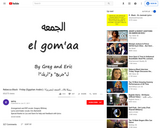
The song "Friday" by Rebecca Black in Arabic for use teaching Arabic.
- Subject:
- Arts and Humanities
- Languages
- Material Type:
- Primary Source
- Date Added:
- 10/20/2013

The song "Friday" by Rebecca Black in Arabic for use teaching Arabic.

"Weird Al" Yankovic might be the first person to come to mind when you think of parody music, but did you know that composers like Bach, Mozart, and Satie have been parodying each other's work for centuries?
Nahre and LA explore the history of parody music from the 1700s to the YouTube parodies of today. Scott Dikkers, founding editor of The Onion, explains why humans love parody so much and why it's so hilarious. Nahre and LA compose a dance hit to the tune of the Barney theme song.

This subject examines interactions across the Eurasian continent between Russians, Chinese, Mongolian nomads, and Turkic oasis dwellers during the last millennium and a half. As empires rose and fell, religions, trade, and war flowed back and forth continuously across this vast space. Today, the fall of the Soviet Union and China’s reforms have opened up new opportunities for cultural interaction.

This website provides a set of course material (in english and german) for undergraduate (bachelor) students in sound engineering and music production among others on the following topics:1/ fundamentals of acoustics for music production: the sound wave, sound sources, interactions and phase, instrumental acoustics, room acoustics2/ fundamentals of psychoacoustics for music production: perception of loudness, perception of pitch and intervals, spatial hearing, perception of timbreThese courses are made available for educational and non-commercial purposes under the terms of the creative commons license “attribution-noncommercial-sharealike 4.0 international (cc by-nc-sa 4.0)”.Pdf versions (without animations and sound examples) are also available on slideshare (https://de.slideshare.net/AlexisBaskind/presentations).Comments and suggestions are of course welcome, don’t hesitate to contact me.

Students will practice listening to German song lyrics for understanding and will ask and answer questions about different artists.

Students will practice asking each other questions related to the different topics they learned about in the class.

Children will love this light and bouncy tune, animated by Bill Belongia, as they learn about the quarter rest. The first time through the song you will see critters in various states of "resting". The second time through the song you see the tap dancing cow give his all. Side note, the cow dance was taken from a routine supplied by our own in house dance expert Liz Wagner.

Learn about the trailblazing, gender non-conforming performer Gladys Bentley with this digital short from Unladylike2020. Gladys Bentley fled her homophobic Trinidadian immigrant family in Philadelphia, PA at age 16 to join New York's Harlem Renaissance jazz scene as a cross-dressing performer. In a time when homosexuality was widely considered sinful and deviant, Bentley wore men's clothing -- a tuxedo and top hat -- and became famous for her lesbian-themed lyrics covering popular tunes of the day, and for openly flirting with women in the audience. In the 1950s, succumbing to pressure from the black church and McCarthy Era harassment of the LGBTQ community, Bentley said of her gender identity, "I am a woman again!" Constantly reinventing herself, Bentley challenged norms and pushed boundaries. Support materials include discussion questions, vocabulary, a research project on queer identity during the Harlem Rennaissance, and a close reading of Bentley's famous essay, "I am a Woman Again".

This course examines contemporary and historical cultural production on and from Africa across a range of registers, including literary, musical and visual arts, material culture, and science and technology. It employs key theoretical concepts from anthropology and social theory to analyze these forms and phenomena. It also uses case studies to consider how Africa articulates its place in, and relationship to, the world through creative practices. Discussion topics are largely drawn from Francophone and sub-Saharan Africa, but also from throughout the continent and the African diaspora.
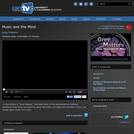
In this edition of "Grey Matters," Aniruddh Patel, of the Neurosciences Institute, discusses what music can teach us about the brain, and what brain science, in turn, can reveal about music. (51 minutes)
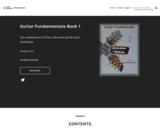
George Arvola (1948-2016) was a guitarist and music teacher. He created his own series of guitar method books entitled Guitar Fundamentals. Volumes 2-5 of this series are based on approximately 600 pages of music manuscript by Tony Bradan (1913-1999) entitled A Learning Process for Playing the Guitar, which Tony entrusted to George. These books outline a process by which serious, dedicated students can gain:the ability to read standard notation for guitar, skill in applying efficient pick control and left hand fingering, an intimate knowledge of the guitar fretboard and flexibility in finding efficient fingerings for melodies, scales, triads, arpeggios and 3- and 4-part chords in real time, the ability to play accompaniment, the ability to play 4-part harmony, chord resolutions and voice movement, and the basics of improvisation. We are preserving this guitar method online in the hope that present and future generations of guitarists will benefit from the innovative approaches within.
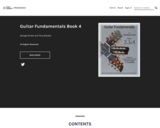
George Arvola (1948-2016) was a guitarist and music teacher. He created his own series of guitar method books entitled Guitar Fundamentals. Volumes 2-5 of this series are based on approximately 600 pages of music manuscript by Tony Bradan (1913-1999) entitled A Learning Process for Playing the Guitar, which Tony entrusted to George. These books outline a process by which serious, dedicated students can gain:the ability to read standard notation for guitar, skill in applying efficient pick control and left hand fingering, an intimate knowledge of the guitar fretboard and flexibility in finding efficient fingerings for melodies, scales, triads, arpeggios and 3- and 4-part chords in real time, the ability to play accompaniment, the ability to play 4-part harmony, chord resolutions and voice movement, and the basics of improvisation. We are preserving this guitar method online in the hope that present and future generations of guitarists will benefit from the innovative approaches within.
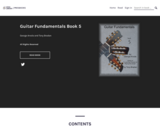
George Arvola (1948-2016) was a guitarist and music teacher. He created his own series of guitar method books entitled Guitar Fundamentals. Volumes 2-5 of this series are based on approximately 600 pages of music manuscript by Tony Bradan (1913-1999) entitled A Learning Process for Playing the Guitar, which Tony entrusted to George. These books outline a process by which serious, dedicated students can gain:the ability to read standard notation for guitar, skill in applying efficient pick control and left hand fingering, an intimate knowledge of the guitar fretboard and flexibility in finding efficient fingerings for melodies, scales, triads, arpeggios and 3- and 4-part chords in real time, the ability to play accompaniment, the ability to play 4-part harmony, chord resolutions and voice movement, and the basics of improvisation. We are preserving this guitar method online in the hope that present and future generations of guitarists will benefit from the innovative approaches within.
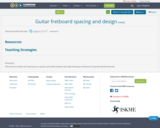
This lesson teaches fret spacing on a guitar and walk students through drawing a fretboard using Autodesk Autocad.

This lesson teaches fret spacing on a guitar and walk students through drawing a fretboard using Autodesk Autocad.
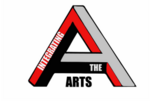
This resource was created by Sandy Schneider, in collaboration with Dawn DeTurk, Hannah Blomstedt, and Julie Albrecht, as part of ESU2's Integrating the Arts project. This project is a four year initiative focused on integrating arts into the core curriculum through teacher education, practice, and coaching.
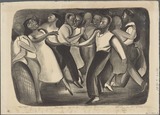
Students will be presented with foundation knowledge of the Harlem Renaissance, experience some sights and sounds of this movement, then gain deeper knowledge by creating a virtual “museum exhibit” of a famous artist or author to share with others. At the end of the lesson, students will evaluate the impact and significance of the Harlem Renaissance, and consider how the arts can serve as vehicles for social change.

In this subject we will study the basic harmonic, melodic, and formal practices of western music, principally the classical music of central Europe during the eighteenth century. Topics will include diatonic harmony, simple counterpoint in two parts, and tones of figuration. The coursework will combine composition, listening, analysis, and work in sight-singing and keyboard musicianship.

This is not a metallurgy class! Learn everything you ever wanted to know about Heavy Metal music. Topics of this video lecture series include musicology, history, metal culture, music theory, songwriting tropes, harsh vocal techniques, extreme metal, tech-based instruments, and how the genre tackles some of today’s biggest sociopolitical challenges. You’ll find out why metal bands exist in every country on Earth, and why you’re probably already a metalhead without even knowing it. This course has been rockin’ MIT’s Independent Activities Period (IAP)* since 2006!
2023 Video Lectures:
Heavy Metal 101: Music and Culture
The Guts of Metal - Music Theory and Songwriting with Colin Brumley
All About Harsh Vocals – History, Application, and Technique with Paul Buckley
History of Heavy Metal, Part I
Connections Between Metal and Literature with Dean Swinford
History of Heavy Metal: Part II
GeoShred and Technology-Based Expressive Musical Instruments with Jordan Rudess
History of Heavy Metal: Part III
The class video lectures from 2021 to the present are available on the site.
*IAP is a 4-week term at MIT in January that provides members of the MIT community with an opportunity to organize, sponsor, and participate in activities and topics that are often outside of the regular MIT curriculum.

This class explores the political and aesthetic foundations of hip hop. Students trace the musical, corporeal, visual, spoken word, and literary manifestations of hip hop over its 30 year presence in the American cultural imagery. Students also investigate specific black cultural practices that have given rise to its various idioms. Students create material culture related to each thematic section of the course. Scheduled work in performance studio helps students understand how hip hop is created and assessed.